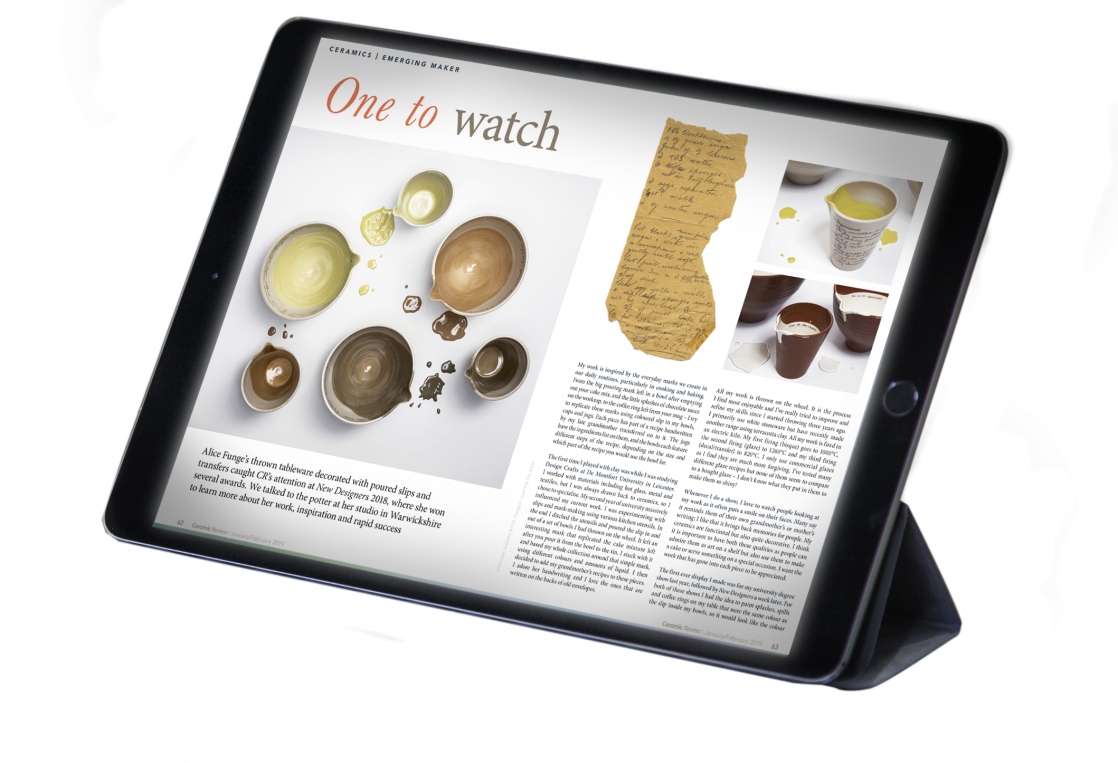Welcome to Ceramic Review
Ceramic Review is the magazine for contemporary and historical ceramics, ceramic art and pottery.
Ceramic Review Issue 334
July/August 2025
Ceramic Review is the magazine for contemporary and historical ceramics, ceramic art and pottery.
July/August 2025
Ebony Russell’s unique way of making ceramics has won her international acclaim discovers Corinne Julius

Ebony Russell sits in her Sydney studio gently turning her wheel with her left hand, in the other she holds a piping bag that she squeezes rhythmically. Not the normal potter’s tool, but the work that Russell produces is not your normal pot. Her vessel forms (they rarely have a solid base) are frothy confections of piped porcelain, like hundreds of little iced gem biscuits loosely attached together in an open web that is almost as much hole as clay.
The overall forms can echo the shape of a Portland vase but the extraordinary thing is that the piped porcelain is the vessel form; there is no underlying structure, no metal or clay framework of support. This is Russell’s technique. The result may seem highly decorative and what might once have been called ‘femininely pretty’, but underlying it is historical context and
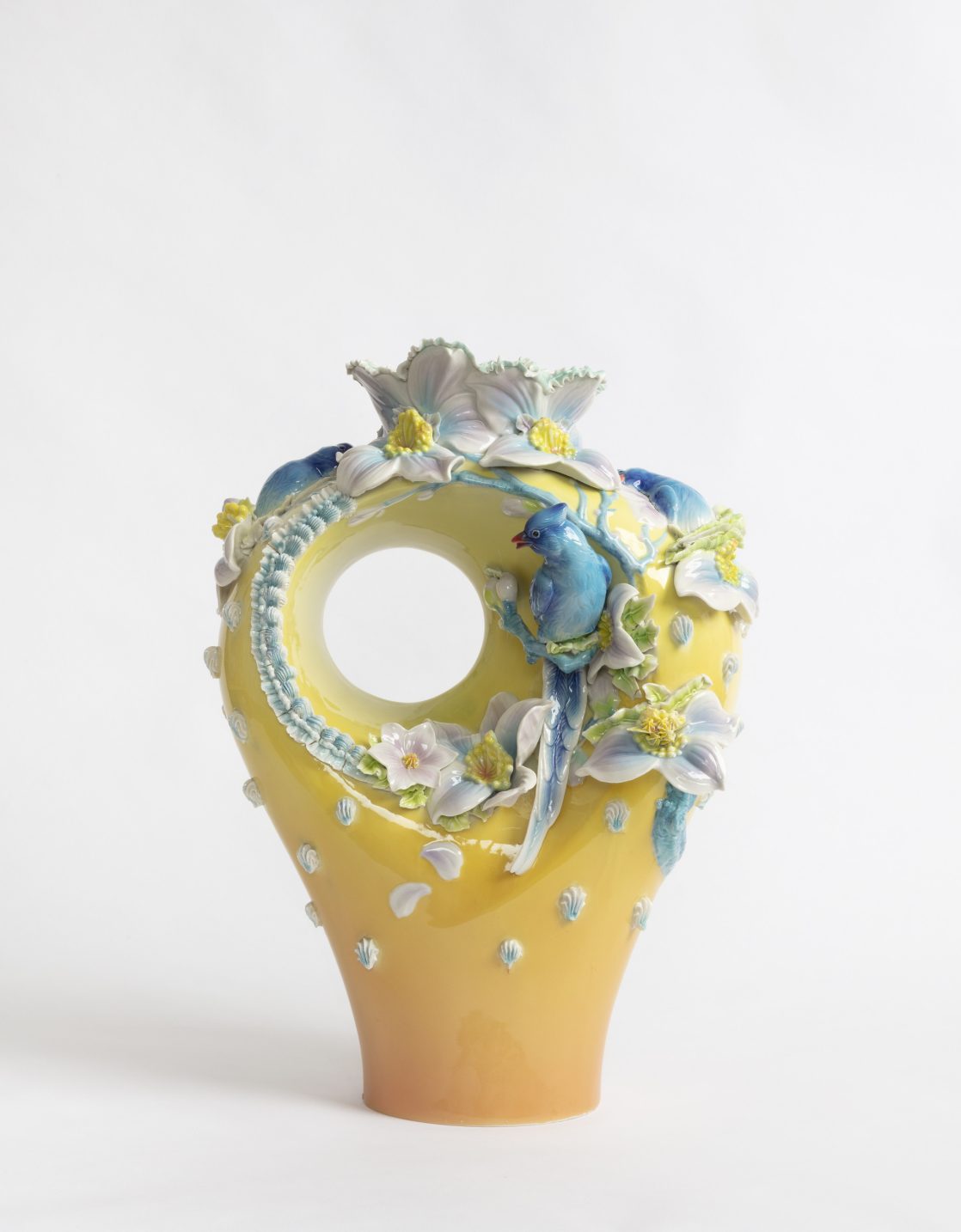
EARLY INFLUENCES
Russell was born in Melbourne, Australia, in 1980, into a family of Maltese-Dutch origin. ‘My home life was strongly coloured by these backgrounds,’ she reveals. ‘The kinds of objects you have around you clearly affect you. In the Dutch house, it was all Delft – everything was blue and white, plus my grandmother collected china dolls, which were everywhere. On the Maltese side, it was a very kitsch, object-based collection, mostly ceramics.’
She was expected to be a homemaker, while her brother got to do things with their father. ‘I was always presented with the idea that I wasn’t going to have as many choices, that my path was already laid out for me. I rebelled against that. I was a feminist, but I didn’t realise I was until I became better educated and read more about it.’
Russell discovered clay as a child and at 16 decided to become a ceramicist, but cannily realised she could follow her dream more easily if she said that she wanted to be an art teacher. She got her BA Hons in ceramics at Monash University and in 2004, started to pipe tiny ballerina figures on ceramic birthday cakes using stoneware. ‘I was looking at the cake as a platform, as a stage,’ she explains. As a child, she adored an Australian woman’s magazine that featured a birthday cake cookbook. ‘You selected your birthday cake from it every year. It was so special. My favourite was either the ballerina cake or the dolly cake with the gown you shoved a Barbie doll in.’
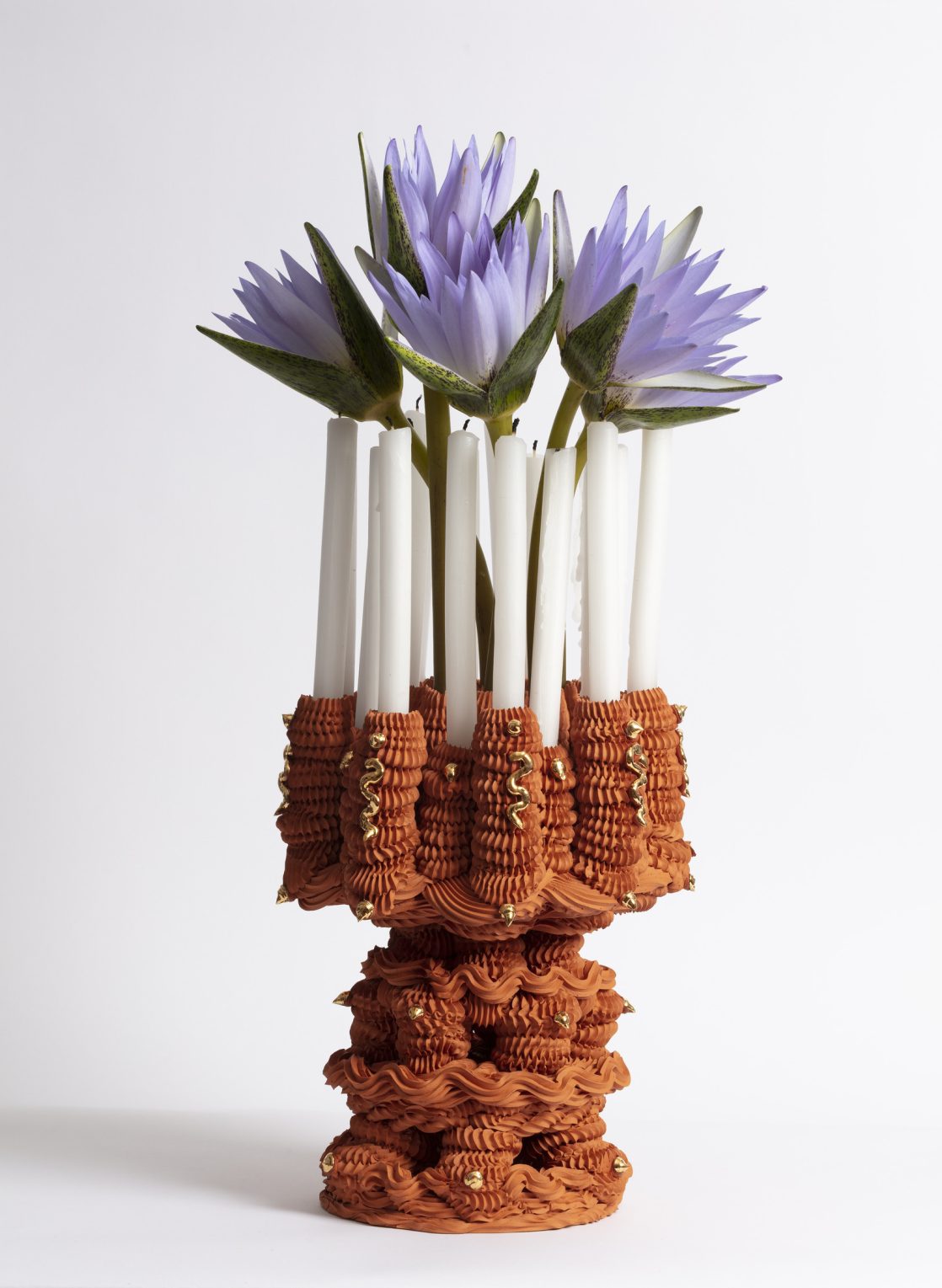
Subsequently she made huge slip-cast and glazed hair ornaments that examined the nature of how we make girls feminine. ‘What I am most passionate about is women’s stories,’ she says. ‘Most of my work comes from an autobiographical place. Everyone told me I was too noisy and that I needed to calm down, that I should be aiming to get a nice job, find a nice man, get married and have some children. I always felt that was so oppressive.’
She finished one year of her Master’s, before completing a teaching qualification and teaching art for 12 years. Later and married with two children, she moved to Queensland and taught at a boarding school with many Aboriginal and Torres Strait Islander students, before moving back to Sydney, completing a Master’s degree at the National Art School and working as a ceramicist. Pottery friends suggested clubbing together to buy some porcelain, ‘and that is where the magic happened. That is where I had “aha” moments, because the combination of porcelain and icing tools worked’.
However, Russell is not a trained cake decorator. ‘I wanted to celebrate the Bonbonnières from weddings; beautiful ballerinas, pretty roses and flowers, all the things that were in the first museum of my life; my grandmother’s china displays and the Maltese lustre ware,’ she explains. ‘I started experimenting with sugar and realised that what I was looking at was to do with safe places as a child; the objects that could act as mnemonic devices to take you back to those moments, those childhood reveries and objects. Then revealing how you feel about that as an adult, when you are disenchanted, when you know the fairy tale is not true.’

MAKING PROCESS
She starts her process by whipping the clay to the right consistency to pipe, with an electric whisk. The piping itself is meditative. ‘I don’t normally put something in a kiln if I am going to lose it,’ she says. ‘Fortunately, my technique lends itself to not having many losses. I don’t have to worry too much about air bubbles as air can escape everywhere. The way I make the work is so slow, that it is almost dry by the time I do the last layer.’
Her work is high-fired once in an electric kiln powered by solar panels. She is not afraid of failure and embraces the leaning nature of some of her pieces: ‘They lean because they are full of holes.’
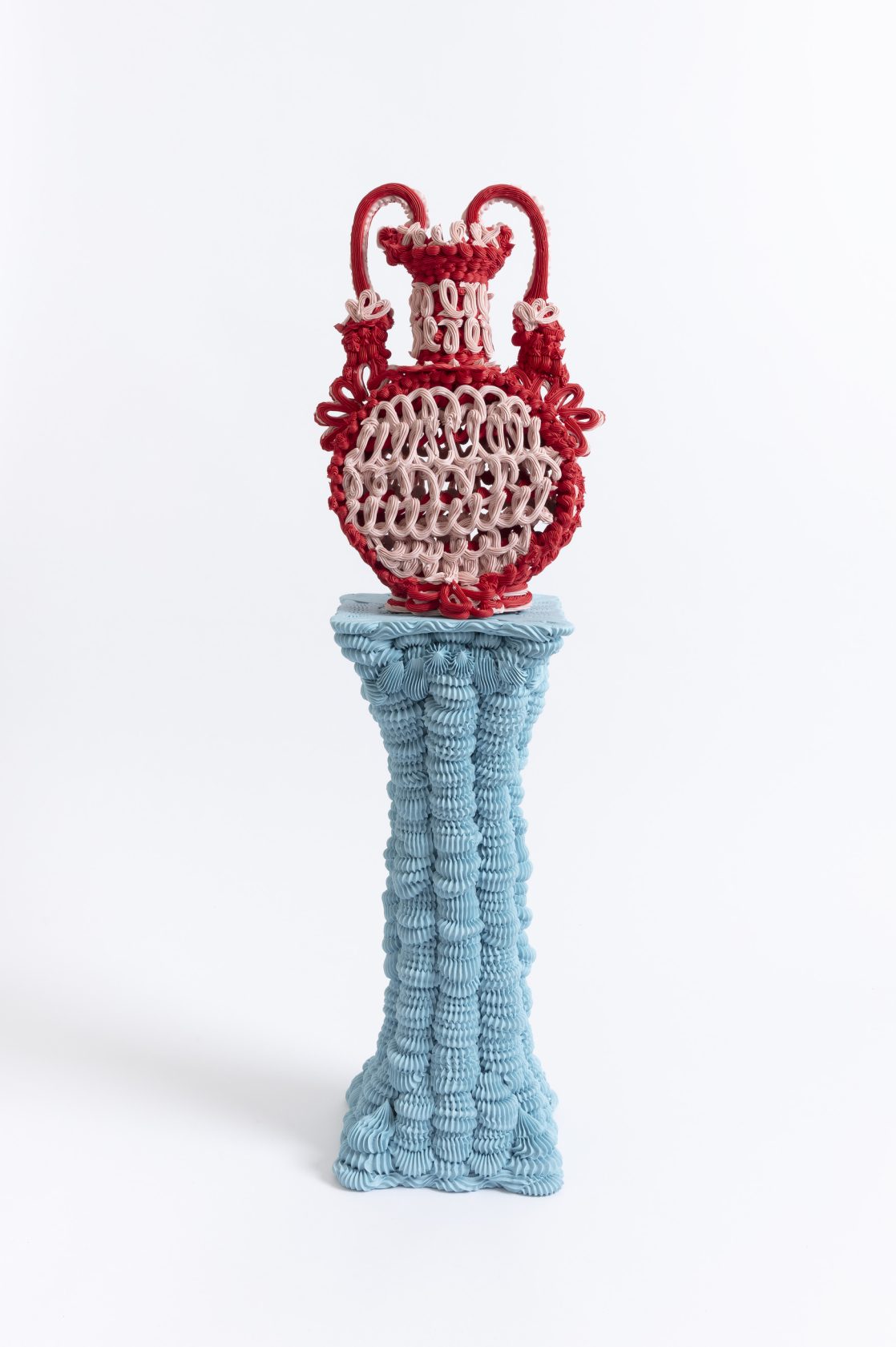
Russell initially piped onto balloons using fast-drying Lumina porcelain that can be whipped, with water added to it so it doesn’t crack. She didn’t want the icing to be just an add-on. ‘I realised I could use the icing as an environment,’ she reveals. ‘I started creating small environments, layering the icing and seeing how far I could push it and what kind of structures I could build. I concluded that I could have my own voice, my own language, and even my own style, technique and process. I needed to make sculptures that gave the look and illusion of something with architecture, or something known as a sculpture or traditional ceramics, without there actually being anything traditional in it.
‘They are not made on the wheel. They are not touched by hand. Yet, they are completely handmade,’ she continues. ‘I want you to look at these vases and ask, is there a vase inside there? How is she doing that? Part of my development is pushing past the known ability to make structures. They are perforated forms and that is not what a traditional pot is. I push that perforation quite strongly; they are sculptures with holes that mimic a vase or urn form. They are like lacework, knitting or sewing. They are made in layers and pieces and attached together. But there is no architecture.’
The fact that architecture is often conceived as a masculine practice makes it particularly important for Russell. ‘I am taking the feminine and making it stronger, or strong enough to stand alone,’ she explains. ‘That is important for me, honouring matrilineal craft practices that were excluded from fine art canons. I was always interested and uncomfortable with the idea of a woman as vessel, and then vessels being described with feminine characteristics.’
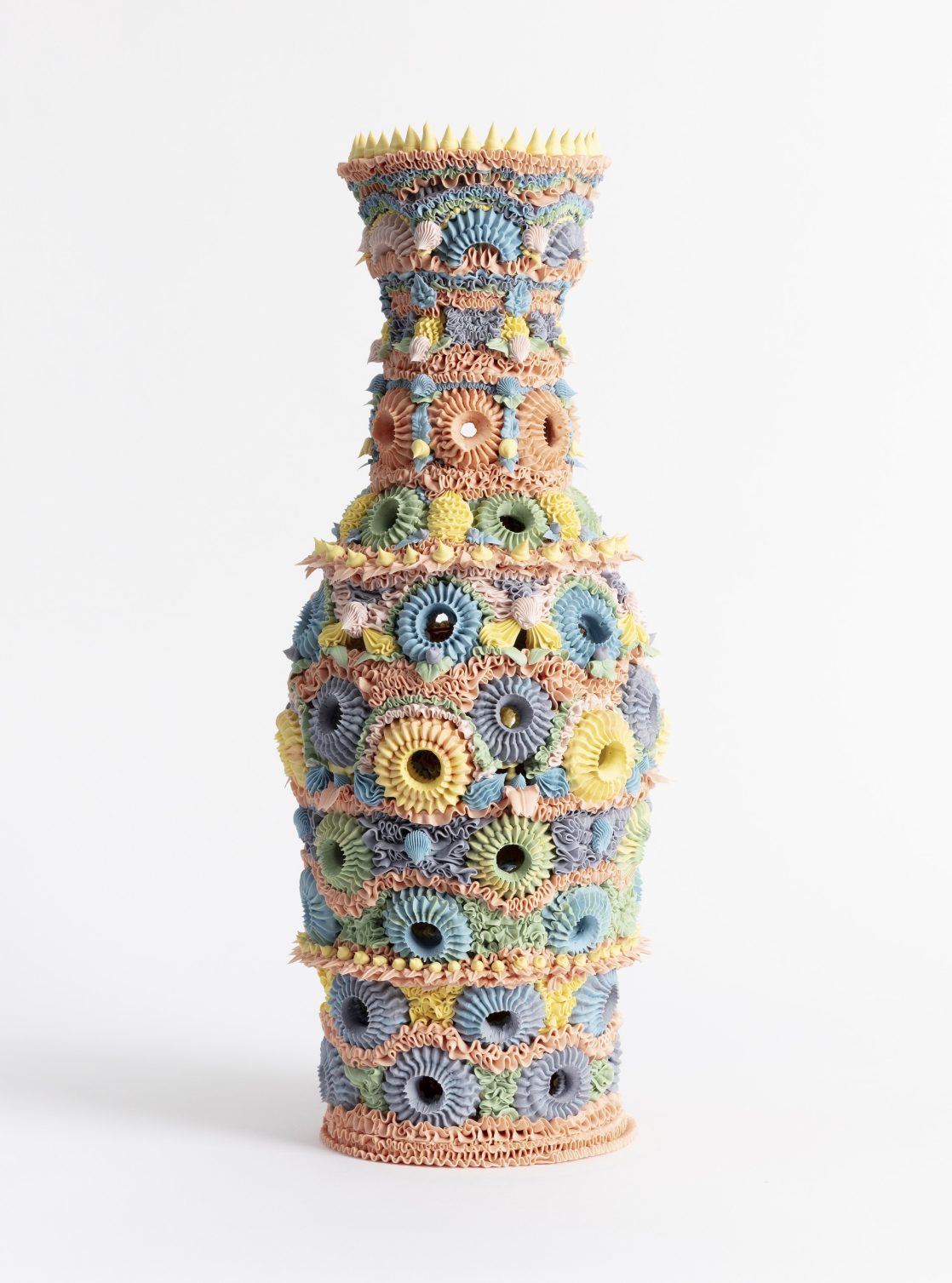
CLAY DYNASTY
Her first solo show Sad Birthday at Artereal Gallery was a series of piped faces that were the serendipitous result of a telephone call on her 39th birthday. Annoyed by the caller, she piped a sad face and dropped it. It squashed. ‘I thought, I have got to stop letting other people’s needs and desires distract me from my own. You can’t control anybody else. You can only control yourself.’ She went on to produce 40 piped, bashed faces of seminal disappointments in her life and two urns Decorative Urn Pink and Useless and Decorative Urn Blue and Hopeless that deal with fertility issues.
Her work was picked up by Eva Czernis-Ryl, Curator of Arts and Design at the Powerhouse Museum Sydney, who commissioned two works in vessel form for an exhibition called Clay Dynasty, which charted Australian ceramics from the 1950s. After researching the collection, Russell was drawn to Wedgwood’s vase on a pedestal Venus and her Swans, after Lebrun. ‘I just loved it,’ she exclaims. ‘I was interested in columns and pedestals, in the way that they are used to hold up and decorate things, but they have structural integrity to them. I wanted to explore making columns. I researched Wedgwood extensively, and really enjoyed the way that Josiah talked about the influence of his wife.’
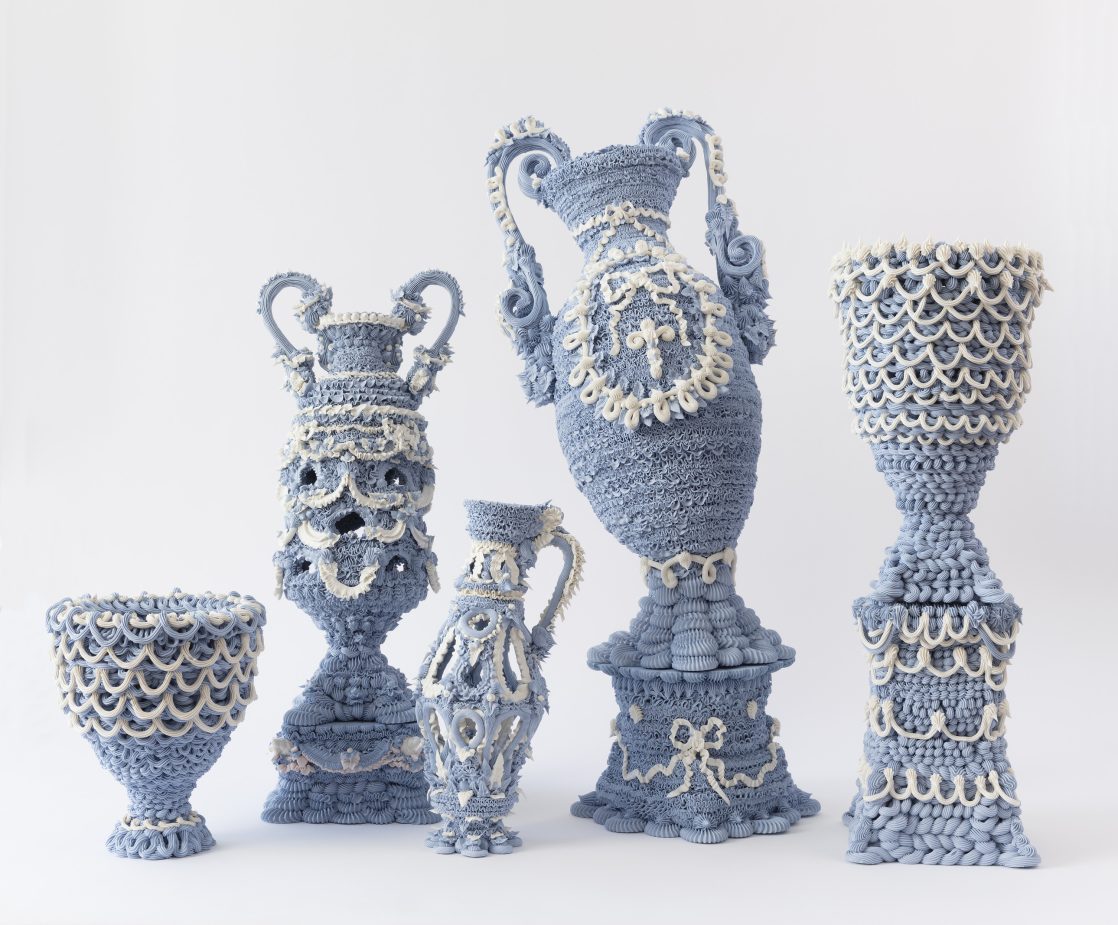
So successful were the works that they were included in the 2023 Powerhouse mega show 1001 Objects and she has gone on to show internationally, including at Homo Faber. This February sees her at Collect in London with Cynthia Corbett where she is also on the five-strong shortlist for the Brookfield Properties Craft Award 2025.
Russell is determined to keep on experimenting and hopes to push the filigree further like Royal Worcester open work. ‘After working with this technique for six years, I have a strong amount of control and lots of ideas.
I want to incorporate glaze into some of the clay as I am piping it so it can melt as it is firing. I am interested in playing with the layers and what additives I can bring into its form of collapse, because I like to push the work to the brink of falling. I like it to look like you think it is going to ooze.’
Ceramic Review is the international magazine for contemporary and historical ceramics, ceramic art and pottery.
As a subscriber to the print magazine, you also get FREE access online to the entire Ceramic Review archive – going all the way back to our first issue in 1970. Digital subscriptions are online only.
